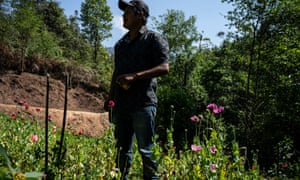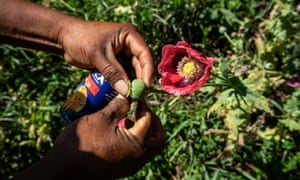02 May Fentanyl use could end the opium era in Mexico: ‘The only crop that paid’ | World news
Every six months over the past two decades, Pedro García has planted a small crop of opium poppies alongside the maize and beans in his hillside field. The modest profits from the flowers’ sticky sap – known in Spanish as goma – paid for his children’s schooling, but now, García, 50, can no longer eke out a living.
“I knew it was illegal, but I took the risk – and thanks to la goma I raised my family,” said García as he regarded the red, pink and purple flowers. “But now it’s over: my children are grown, the goma era is finished.”
Mexico is the main source of heroin trafficked to the US, with some 75,000 acres of opium poppy production in 2017.
But drug use in the US has shifted: addicts have increasingly swapped heroin for fentanyl – an ultra-potent synthetic opioid often manufactured in China. As a result, the market price for opium in Mexico’s top poppy-growing state, Guerrero, has plummeted from $1,300 a kilo to $200.
The fentanyl crisis has been responsible for tens of thousands of deaths in the US. But it also seems likely to bring about what half a century of the militarized war on drugs has been unable to achieve: forcing impoverished farmers in rural Mexico to abandon the narcotics trade.
The opium decline is wreaking social and economic havoc in countless rural communities where peasant farmers like García now face tough choices: persuade Mexican authorities to help introduce alternative cash crops, accept environmentally destructive mining projects – or migrate north.
Zilacayota is a picturesque village of indigenous Tlapaneco people living in adobe houses with no phone signal, doctor or paved roads. It lies in the municipality of Acatepec – the biggest opium producer in Guerrero’s La Montaña region.

The poppy trade began here in the 1970s: community elders remember military officers bringing seeds and experienced farmhands from Sinaloa state – a move some believe was later used to justify a crackdown on the region’s guerrilla movements.
The trade gained widespread popularity in the 1990s, after disease outbreaks and free trade agreements like Nafta made traditional crops such as coffee and maize unprofitable.
In some parts of Guerrero, vast poppy plantations are controlled by organised crime groups whose turf wars have turned rural communities into battle zones. It was in northern Guerrero that 43 trainee teachers were forcibly disappeared by corrupt police in September 2014; independent investigators believe they unwittingly commandeered a bus loaded with heroin.

Why did Mexico launch its war on drugs?
On 10 December 2006, president Felipe Calderón, launched Mexico’s war on drugs by sending 6,500 troops into his home state of Michoacán, where rival cartels were engaged in tit-for-tat massacres.
Calderón declared war eight days after taking power – a move widely seen as an attempt to boost his own legitimacy after a bitterly contested election victory. Within two months, around 20,000 troops were involved in operations across the country.
What has the war cost so far?
The US has donated at least $1.5bn through the Merida Initiative since 2008, while Mexico has spent at least $54bn on security and defence since 2007, over 250,000 people have been murdered, more than 40,000 reported as disappeared and there are 26,000 unidentified bodies in morgues across the country. Human rights groups have also detailed a vast rise in human rights abuses including torture, extrajudicial killings and forced disappearances by state security forces.
Peña Nieto claimed to have killed or detained 110 of 122 of his government’s most wanted narcos. But his biggest victory – and most embarrassing blunder – was the recapture, escape, another recapture and extradition of Joaquín “El Chapo” Guzmán, leader of the Sinaloa cartel. Guzman was found guilty of drug trafficking charges in a New York courtroom and faces multiple life sentences in the US, but will never pay for his crimes in Mexico.
Mexico’s decade-long war on drugs would never have been possible without the huge injection of American cash and military cooperation under the Merida Initiative. The funds have continued to flow despite indisputable evidence of serious human rights violations.
Under new president Andrés Manuel López Obrador, murder rates are up and a new security force, the Civil Guard, is being deployed onto the streets despite campaign promises to end the drug war and facilitate national reconciliation.
What has been achieved?
Improved collaboration between the US and Mexico has resulted in numerous high-profile arrests and drug busts. Officials say 25 of the 37 drug traffickers on Calderón’s most-wanted list have been jailed, extradited to the US or killed, although not all of these actions have been independently corroborated.
The biggest victory – and most embarrassing blunder – under Peña Nieto’s leadership was the recapture, escape and another recapture of Joaquín “El Chapo” Guzmán, leader of the Sinaloa cartel.
While the crackdown and capture of kingpins has won praise from the media and US, it has done little to reduce the violence.
How is the US involved?
Mexico’s decade-long war on drugs would never have been possible without the huge injection of American cash and military cooperation under the Merida Initiative. The funds have continued to flow despite growing evidence of serious human rights violations.
But in La Montaña, opium production has thrived thanks to an abundance of campesinos with small plots. Opium buyers known as burreros visited isolated communities and transported the morphine-rich sap to labs controlled by criminal gangs to be processed into heroin.
“La goma is the only crop that paid – nothing else sold at the market,” said Julia Sánchez, a widow with 10 children, who harvested 100 grammes or so of opium twice a year until forced to sell the family land to pay for her husband’s funeral.
The global drug trade is worth an estimated $320bn annually, according to the UN, but profits are mostly shared by traffickers and retailers in consumer countries.
After more than 30 years at the bottom rung of the drug trade, 97% of the population in Acatepec still live in poverty, with a staggering 69% in extreme poverty, according to the latest official figures, compared with the national average of 44% poverty and 8% extreme poverty.
The poppy boom in La Montaña resulted from the lack of alternatives, said Abel Barrera Hernández, founder of local human rights organisation Tlachinollan. “Here, people don’t see la goma as a criminal problem. For them it’s always been an issue of survival.”
Nevertheless, the trade did bring disposable income to the region: boozy village fiestas became legendary, children were clothed and well-fed, and out-of-town vendors made the arduous uphill journey to sell everything from school supplies and junk food to guns and stolen cars.
Now, the fiestas have downsized, children come to school hungry, and the vendors have stopped coming – as have the burreros.
After her husband’s death, Sánchez earned $4 (80 pesos) a day farming her neighbours’ poppy crops, while her daughters cleaned their houses. This year, no one is hiring and the family is living off shop credit and occasional remittances from her sons who migrated to nearby towns.
“I don’t know what la goma is used for – they say drugs but I don’t know what that means. All I know is the only thing we know how to farm doesn’t sell any more. We’re desperate.”
Many here believe the opium price crash is linked to the downfall of Joaquín “El Chapo” Guzmán; a minority have heard it is linked to a new Chinese drug.
So far, the Mexican government has failed to address the crisis, and some claim things have got worse since President Andrés Manuel López Obrador took power in December 2018.

In January, military helicopters sprayed parts of the valley with a white liquid chemical that destroyed not just poppies, but also courgettes, chickpeas and bean crops. It was the first aerial fumigation in Zilacayota in over a decade. (The army claims to have destroyed 221,000 hectares of poppies across Guerrero in the past 30 years, including almost 6,000 hectares in Acatepec.)
Environmental factors linked to soil erosion and climate change are also starting to affect the viability of poppy farming in Guerrero.
David Navarro, 26, an ambitious father of two who produced 4kg of opium last year, is now contemplating migrating to the US. “This work isn’t secure. Even if the price goes back up for a while, climate change will end the poppy business here – the weather is changing, it’s getting drier,” he said.
Amid the chaos and crackdowns at the US border, the going rate charged by local coyotes stands at $8,000 to $10,000. Navarro has some opium stashed away, hoping the price will rise a little, but it wouldn’t cover the migration passage.
Instead, he will probably join thousands of mostly indigenous campesinos travelling to northern Mexico as seasonal agricultural workers.
The US fentanyl crisis could mark the end of an era for Mexico – but what comes next depends on what fills the opium vacuum. Violence could increase as criminal gangs compensate for falling drug profits by ramping up extortion, vehicle thefts and kidnappings.
“This [price drop] could be a great opportunity to help communities regenerate traditional agriculture. But it could also open the door for mining companies” said Barrera Hernández.
Growing numbers of farmers seem resigned to the end of the opium era, but others are finding it hard to let go.
Miguel Romero, 30, started farming poppies as a school boy. He has harvested as much as 14kg in recent years, living relatively well as a result – but saved nothing. “We thought the good times would last forever, never imagined that the price would fall.”
In recent months Romero found construction work in a nearby town, and has experimented with fish and chicken farming, but his heart is not in it. “La goma is what I know, I don’t want to do anything else. I still have hope the price will go back up.”
[ad_2]
Source link



No Comments